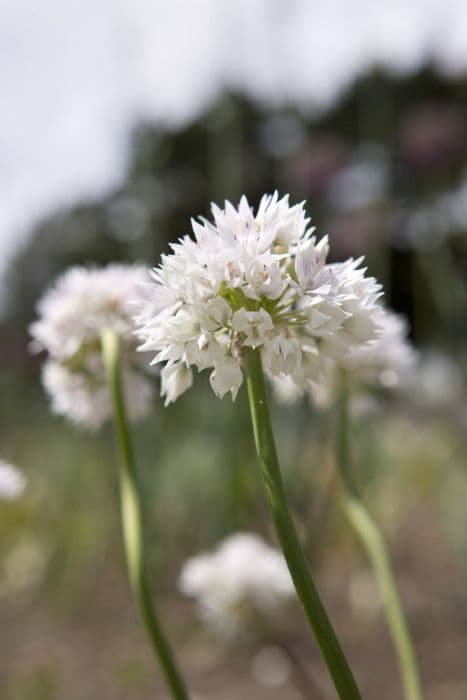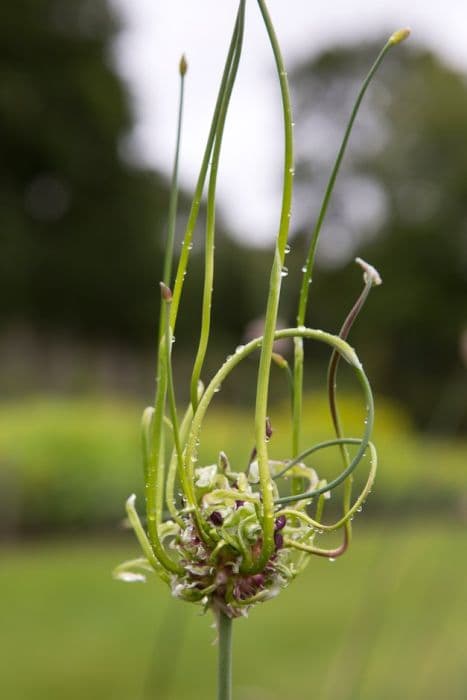Ornamental Onion Allium jesdianum 'White Empress' (PBR)

ABOUT
The Allium jesdianum 'White Empress' is adorned with elegant, large, spherical clusters of star-shaped flowers. These blossoms boast a pristine white color, giving the plant a regal and sophisticated appearance, as suggested by its name 'White Empress'. The flowers form a dense globe that sits atop sturdy, upright stems, creating an eye-catching display. The foliage of this ornamental onion consists of broad, strap-shaped leaves that are of a lush green color, which adds to the overall lushness of the plant. The contrast between the vibrant green leaves and the pure white flowers further accentuates the plant’s stunning visual impact. The leaves typically emerge from the base, providing a lush backdrop for the floral spheres that rise above. This ornamental onion blooms in the late spring or early summer, bringing a burst of brightness to the garden during this time. The striking white blossoms are not only visually appealing but may also attract butterflies and bees, adding movement and life to its display. This plant is valued for its ability to bring strong vertical interest and architectural qualities to a garden setting, making it a popular choice for borders, beds, and as a focal point in ornamental gardens.
About this plant
 Names
NamesSynonyms
Jesdian Allium, White Empress Onion.
Common names
Allium jesdianum 'White Empress' (PBR)
 Toxicity
ToxicityTo humans
The plant known as Allium jesdianum 'White Empress' (PBR), commonly referred to as Ornamental Onion, is generally not toxic to humans. There are no significant reports of poisoning from ingestion of this plant. However, as with many plants, it is still advisable not to eat it as it might cause mild stomach discomfort in some individuals.
To pets
Ornamental Onion or Allium jesdianum 'White Empress' (PBR) is toxic to pets, especially cats and dogs. If a pet ingests this plant, symptoms of poisoning can include vomiting, diarrhea, abdominal pain, lethargy, and increased heart rate. Severe cases might lead to anemia or even complications that could be life-threatening if not treated promptly. It is important to keep this plant out of the reach of pets and to seek veterinary care if you suspect your pet has ingested any part of it.
 Characteristics
CharacteristicsLife cycle
Perennials
Foliage type
Deciduous
Color of leaves
Green
Flower color
White
Height
2-3 feet (60-90 cm)
Spread
1-2 feet (30-60 cm)
Plant type
Bulb
Hardiness zones
4-9
Native area
Middle East
Benefits
 General Benefits
General Benefits- Ornamental Appeal: The 'White Empress' ornamental onion adds aesthetic value to gardens with its striking white blooms and statuesque appearance.
- Attracts Pollinators: This plant is known to attract bees and butterflies, thereby aiding in the pollination of surrounding plants.
- Low Maintenance: Typically requires minimal care once established, making it suitable for gardeners of all skill levels.
- Drought Tolerance: Once established, the ornamental onion has good drought tolerance, reducing the need for frequent watering.
- Deer and Rodent Resistant: This plant is not a preferred food source for deer and rodents, which can help to reduce garden damage.
- Long Blooming Period: 'White Empress' has a lengthy blooming period, providing long-lasting color in the garden or landscape.
- Cut Flower Garden Addition: The long stems and attractive blooms make it an excellent choice for a cut flower garden.
- Seasonal Interest: Its late spring to early summer blossoming period adds interest to the garden at a time when many spring bulbs are finished blooming.
 Medical Properties
Medical PropertiesThis plant is not used for medical purposes.
 Air-purifying Qualities
Air-purifying QualitiesThis plant is not specifically known for air purifying qualities.
 Other Uses
Other Uses- Ornamental centerpieces: The tall, elegant white flowers of the 'White Empress' make striking centerpieces for tables during events and can last for several days if properly cared for in water arrangements.
- Photography prop: The distinct form and color of the 'White Empress' can serve as an excellent photography prop, adding depth and interest to garden photography or plant-focused photo shoots.
- Education: This plant can be used in educational settings to teach plant biology, particularly bulb growth cycles, pollination, and plant maintenance.
- Art inspiration: Artists may use the 'White Empress' as a subject for paintings, drawings, and other forms of visual art due to its unique appearance and texture.
- Marker in a garden: Because of its height and distinctive look, 'White Empress' can act as a natural marker, indicating the end of a row in a garden or highlighting specific areas.
- Culinary garnish: While care must be taken to ensure that no parts are toxic, some Allium flowers can be used to garnish plates and add a touch of elegance to high-end dishes.
- Garden fragrance: The 'White Empress' can contribute a subtle fragrance to gardens that can be particularly noticeable during the evening, enhancing the sensory experience.
- Theme gardens: 'White Empress' can be included in monochromatic or white-themed gardens to create a harmonious visual experience.
- Wedding bouquets: The flowers of the 'White Empress' can be incorporated into wedding bouquets to add height and grandeur to bridal florals.
- Ecosystem support: By planting 'White Empress', gardens can provide early season pollen for bees and other pollinating insects, supporting local ecosystems.
Interesting Facts
 Feng Shui
Feng ShuiThe Ornamental onion is not used in Feng Shui practice.
 Zodiac Sign Compitability
Zodiac Sign CompitabilityThe Ornamental onion is not used in astrology practice.
 Plant Symbolism
Plant Symbolism- Unity: Alliums, with their globe-shaped blooms, represent unity and togetherness, symbolizing how individual flowers come together to form one spherical cluster.
- Patience: As a plant that takes a while to bloom and comes to fruition late in the spring or early summer, the Allium jesdianum 'White Empress' embodies patience and the anticipation of rewards to come with time.
- Prosperity: Often used in gardens for their ornamental value, alliums like the White Empress can signify growth and abundance due to their lush and full-headed appearance.
- Pride: Their tall, stately stalks and prominent blooms can represent pride or self-confidence, rising above others in the garden with a striking presence.
- Good Fortune: In some cultures, alliums are believed to bring good luck because of their robust and hardy nature, which can be a metaphor for resilience and the ability to thrive.
- Eternal Life: The round shape of the blooms has been associated with eternity and ongoing life, echoing the cyclical nature of life and the seasons.
 Water
WaterThe Ornamental Onion 'White Empress' should be watered deeply but infrequently to mimic its natural dry habitat conditions. It's best to water this plant once a week with about an inch of water, which equates to approximately 0.62 gallons for a medium-sized garden area. During periods of hot weather or drought, increase watering to twice a week. Ensure the soil is well-draining to prevent waterlogging. Avoid overhead watering to minimize the risk of fungal diseases; instead, water at the base of the plant.
 Light
LightOrnamental Onion 'White Empress' thrives best in full sun conditions, receiving at least six hours of direct sunlight each day. A south or west-facing garden spot that is exposed to the full intensity of the sun is ideal for this plant. In regions with very intense sun, some light afternoon shade may help prevent scorching.
 Temperature
TemperatureThe Ornamental Onion 'White Empress' is hardy and can tolerate a wide range of temperatures, thriving best between 55°F to 75°F. It can survive minimum temperatures down to about -20°F and maximum temperatures as long as they do not exceed 90°F. The plant goes dormant after flowering, during which time it is less sensitive to temperature extremes.
 Pruning
PruningThe Ornamental Onion 'White Empress' should be pruned to remove spent flower stems and any yellowing foliage to maintain a tidy appearance and encourage healthy growth. Pruning can be done immediately after blooming, typically in late summer. Deadheading, or cutting off the flower heads, will not promote further flowering but will prevent the plant from self-seeding if desired.
 Cleaning
CleaningAs needed
 Soil
SoilOrnamental Onion prefers well-draining soil with plenty of compost or organic matter. The soil should have a pH between 6.0 and 7.0. A mixture consisting of loam, peat, and sharp sand or perlite ensures optimal growth conditions for 'White Empress' Allium.
 Repotting
RepottingOrnamental Onion generally does not require frequent repotting and can be left undisturbed for several years. If necessary, repot during its dormancy period, which is after the foliage has died back in late summer.
 Humidity & Misting
Humidity & MistingOrnamental Onion does well in average garden humidity levels. It does not have specific humidity requirements and can thrive in the varying humidity levels typically found outdoors.
 Suitable locations
Suitable locationsIndoor
Ensure bright indirect light and good air circulation for indoor Ornamental Onions.
Outdoor
Plant in full sun to partial shade in well-draining soil for outdoor Ornamental Onions.
Hardiness zone
4-9 USDA
 Life cycle
Life cycleAllium jesdianum 'White Empress' commonly known as the Persian shallot, starts its life as a bulb, which will undergo a period of dormancy, typically during the colder months. In the spring, the bulb sends up shoots, and leaves start to develop, harnessing sunlight to grow and build energy reserves. Following the foliage development, the plant will produce a tall stem which bears a large spherical cluster of star-shaped white flowers, usually blooming in late spring to early summer. After flowering, the plant sets seed, and once the seeds mature, they are dispersed, potentially giving rise to new plants if conditions are favorable. As the flowering ends, the foliage begins to yellow and wither, indicating the plant's return to dormancy, during which the bulb remains underground. The cycle repeats yearly, with the bulb re-sprouting the following spring to start the process anew.
 Propogation
PropogationPropogation time
Spring-Early Summer
The Allium jesdianum 'White Empress' (PBR), commonly known as Persian Onion, is often propagated by dividing the bulbs. The optimal time for this method is in the autumn, when the plant has died back and is dormant. To propagate by division, carefully lift the clump of bulbs from the ground and gently separate them, ensuring that each section has at least one growing point. Replant the divisions immediately at a depth of about 6 to 8 inches (15 to 20 centimeters), allowing sufficient space for the bulbs to develop. Water well after planting to help establish the newly divided bulbs. This straightforward method preserves the characteristics of the 'White Empress' and is the most popular way gardeners increase their stock of this particular cultivar.








